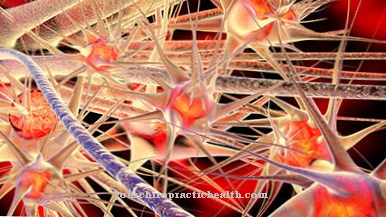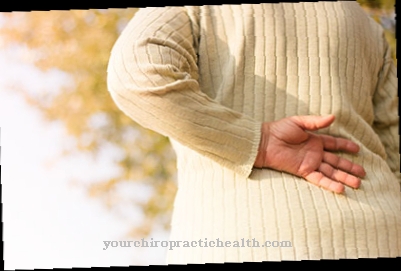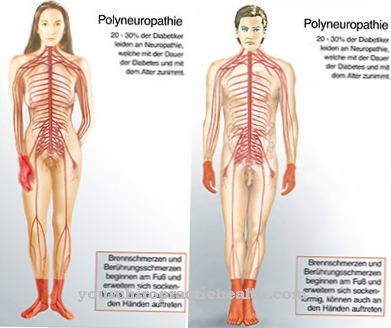At Stretch marks it concerns cracks in the connective tissue, which can occur when the skin is stretched. As a rule, they are perceived as annoying for cosmetic reasons, but they do not cause any health impairment. As a preventive measure, massages and contrast baths are recommended. Complete removal of stretch marks is not possible, but there are a number of treatments that can improve the appearance of the skin.
What are stretch marks?

© juefraphoto - stock.adobe.com
As Stretch marks is the term used to describe the tears in the connective tissue of the subcutaneous tissue that occur more frequently during pregnancy.
Body regions that are particularly susceptible are the abdomen, hips, buttocks, breasts and upper arms. Due to the rapid growth of the belly and breasts during pregnancy, the skin there is exposed to enormous stress.
The elasticity of the skin reaches its natural limits and tears. Stretch marks are purely a cosmetic problem and do not cause any pain or other problems. Over time, the bluish-red stripes fade to light scars.
causes
Stretch marks arise from the strong stretching of the connective tissue during pregnancy. Due to hormonal changes during pregnancy, the elasticity of the skin decreases. This favors the development of stretch marks.
Some other factors can also contribute to the development of stretch marks. These are, for example, a weak connective tissue as well as strong and rapid weight gain during pregnancy.
The changes in the body cause the connective tissue to stretch and tear. The bluish-red color of the stretch marks is caused by the blood vessels running underneath. Stretch marks cannot only appear during pregnancy. They can also result from rapid growth, exercise, medication, or being overweight.
Symptoms, ailments & signs
If stretch marks appear, these are mainly diagnosed by the person concerned. They arise in those parts of the body where the skin is particularly affected by the stretching caused by pregnancy.The roughly parallel bluish-red stripes can be seen as fine cracks at the beginning.
Later, as the fabric is stretched, they become wider. These skin strips will no longer recede because the skin is permanently damaged. Light scars remain. Usually stretch marks don't cause pain. In rare cases, the tissue under the skin can become inflamed and the skin changes. In this case, pain can also arise.
This must then be presented to the doctor immediately. Mental health problems are more common when the stripes can still be seen after pregnancy. Many women no longer feel attractive and suffer from the visible streaks. Anyone who would like to find out more about treatment options for stretch marks should consult a doctor as soon as possible.
The scars can be weakened and the skin's appearance improved, for example with creams that contain vitamin A acid or with a chemical peel containing glycolic acid. Glycolic acid stimulates the production of new epidermal cells. The skin can also be treated with other methods such as lasers.
Complications
Stretch marks are injuries under the skin that, like all wounds, can become inflamed. However, this is very rarely the case with stretch marks. As a rule, the stretch marks turn dark in color during the acute injury phase and fade during the healing process. Severe stretch marks, such as those women often suffer during pregnancy, remain visible.
If complications arise, they usually result from a disruption in the healing process. The sores under the skin can then become infected. Instead of gradually receding, the cracks become more visible, in severe cases swelling also occurs, and the skin overlying the stretch marks changes. The inflamed areas of the skin often feel hot, in severe cases even pain can occur. Affected women should then immediately consult a doctor.
Much more often, however, stretch marks lead to psychological problems. In particular, when the stretch marks are clearly visible and not only appear on the stomach, but also on the hips, thighs and breasts, many women feel downright disfigured. Patients who suffer mentally from unsightly stretch marks should consult a dermatologist or plastic surgeon as soon as possible and find out about the treatment options.
When should you go to the doctor?
Usually, there is no need to see a doctor for stretch marks. The disease does not have a negative impact on the health of the person concerned. However, stretch marks can lead to emotional distress and thus give rise to cosmetic treatment.
See a doctor even if the stretch marks cause pain or are scarred. In the case of stretch marks, a dermatologist or a general practitioner can primarily be seen. Further treatment is then carried out by a specialist, depending on the severity and type of stretch marks.
Treatment & Therapy
It is not yet possible Stretch marks remove completely. There are, however, means of weakening the pitted lines so that they are perceived as less annoying. One way to improve the complexion is to regularly apply creams containing vitamin A acid.
A chemical peel with glycolic acid also reduces the stretch marks. Glycolic acid stimulates the production of new epidermal cells and thereby strengthens the epidermis. Another method is what is known as microdermabrasion. The epidermis is gently rubbed off. This treatment does not cause pain and makes the skin more elastic again. Microdermabrasion can also be combined with glycolic acid treatment.
Dermabrasion involves using a device to rub the surface of the skin. This treatment is usually done with a local or brief anesthetic. The stretch marks can also be removed using a laser. Since the layers of the epidermis are removed, the treated parts of the body are reddened and swollen for a few days.
A painful wound is created that is covered with scabs. Surgical removal of stretch marks is also possible. Here, however, the entire area of skin with stretch marks must be removed, which results in the formation of scars.
prevention
Around Stretch marks To prevent this, it is advisable to massage the skin on the particularly heavily stressed body parts regularly. Massages stimulate the blood flow to the connective tissue, which results in increased elasticity. From the third month of pregnancy, the skin should be massaged twice a day.
The so-called plucking massage is particularly suitable, in which the skin is lifted between the thumb and forefinger and gently rubbed and twisted between the fingertips. The effect of such a massage can be increased by using oil. Oil massages of the abdomen and thighs with circular movements are also very effective. Oil is preferable to a cream because it does not absorb into the skin as quickly. There is a large variety of products on the market with natural ingredients such as grapeseed oil, sesame oil or wheat germ oil.
These can also be used without hesitation during pregnancy. A pleasant side effect of a massage with oil is that the skin feels less tight. The itching of the skin on the abdomen, which often occurs during pregnancy, is also reduced. Alternating pouring of cold and warm water as well as brush massages also stimulate blood circulation and have a positive effect on preventing stretch marks.
Aftercare
A skin that has developed stretch marks once will tend to do so again and again. The affected patient doesn't even have to be pregnant. Rapid weight gain can also lead to stretch marks. However, they may then be located in other places, for example on the inner thighs.
Therefore, what is also important for prevention applies to the aftercare of stretch marks by and large: In addition to active weight management, the patient can reduce the appearance of existing stretch marks and prevent further occurrence of stretch marks with regular massages of the affected and endangered skin areas.
There are now various oils on the market that are said to have a good effect in combating stretch marks. More important than the choice of oil is the regularity in which it is used. In general, adequate skin care is important, especially if the patient has decided to treat the stretch marks invasively or even surgically.
Here, the care reduces the risk of unsightly scars developing. Exercising and going to the sauna are good ways to get blood flowing to the skin. In turn, good circulation promotes the regeneration process. Generally, however, stretch marks are a purely cosmetic problem. If it is overrated, short psychotherapeutic therapy can help focus on more important things.
You can do that yourself
Stretch marks are a phenomenon that is largely genetically determined. Nevertheless, a certain influence from the woman is possible within the framework of self-help. This refers to the regular application of lotion to the affected areas on the abdomen and buttocks. It is best to start the routine in the first trimester and not just when stripes are already being formed. A belly band can also prevent the stripe as it has a supportive effect. Here, women are particularly well advised to see a midwife. The tissue can also be loosened with hot water, so that long baths are more likely to be avoided.
Stretch marks cannot always be avoided. Then it is part of the woman's self-help to deal with it positively. She can tell herself that the price of a longed-for child is to have a few streaks on your stomach. In severe cases, the psychologist can be consulted or, of course, the midwife can always be asked for advice. The man, or father of the child, can also relativize the influence of stretch marks on the psychological state of women by confirming them as aesthetically unproblematic. After giving birth, the woman is asked to do postnatal exercises and regular creaming for some time.




.jpg)

.jpg)




















